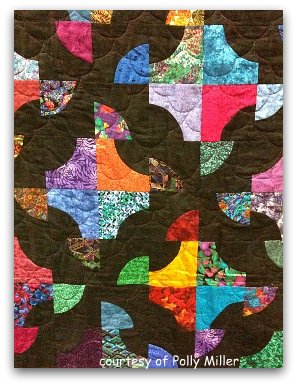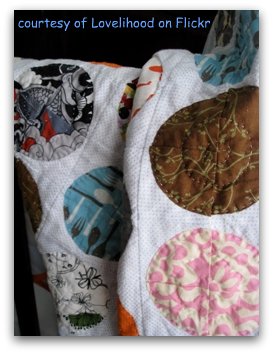The Scrap Quilt:
Yesterday’s Scrapbook

Why tackle a Scrap Quilt?
Well did you ever wonder why scrapbooking is such a far-reaching phenomenon today? Scrapbooks are a way to capture memories, share stories, and just have fun. They are collections of memories, stories, and good times.
In the same way, a scrap quilt is simply a way of taking pieces of fabric and putting them together in memory of certain events or in celebration of others- and yes, to have fun.
Scrapbooking can be time consuming, somewhat limiting due to professional supplies needed, and costly.
In contrast, scrap quilting is usually less costly due to the use of left-over quilting fabric, and can be either time consuming (for larger projects) or not (for smaller projects).
Creating a Scrapbook or a Scrap Quilt can be an individual project or a group project. The idea of getting together for quilting parties or scrapbooking parties is to be creative, share memories, and most of all, have fun.
Finding scraps of quilting fabric from your child’s first dress or favorite blanket and adding them to the quilt is as fun as finding photos of summer vacation and adding them to the memory book.
There are many quilt books about how and why scrap quilting evolved. The main thing to remember is that necessity is the mother of invention. Before Wal-mart, thick quilts for cold nights were hard to come by and it was cheaper to make your own. Before cell phones, texting, and web cams came along, and even before telephones, women used to get together regularly for various activities such as church suppers, barn raisings, fall festivals, and the like. Often, they would bring some of their work with them whether it was knitting or quilting. Special occasions, such as quilting bees, were set aside to help each other in the various stages of their quilting (usually the last part- sewing it all together).
The appeal of scrap quilting is that pieces are small enough to bring along in a sewing basket or shoulder bag. Each block or pattern can be worked on separately- just like crocheting granny squares to later be sewn together into an afghan. The complexity of the block depends on the skills of the quilter. Geometrical shapes such as squares, triangles, and rectangles are often used. Some quilters like the challenge of using curved pieces, circles, and even three-dimensional fabric flowers. All of these use left-over scrap pieces of fabric and thus the name “scrap quilt.”

There are many quilt books and magazines dedicated to the art of quilting. To learn more about historical quilt patterns, The Metropolitan Museum of Art’s American Quilts & Coverlets shows some beautiful pieces using many simple designs. For a study in complex quilts, see Jennifer Buechel’s Miniature Baltimore Album Quilts. One can usually find a local quilting group or guild or at least a needle arts group nearby. These groups usually have a seasoned quilter who can also suggest resources.
If you don’t have scraps, a good fabric store sells “fat quarters” which are a quarter-yard of fabric; usually leftovers or end pieces of bolts of fabric. Sometimes, these will be bundled together in similar colors or patterns for a special deal.
Patterns are legion. Even the most complicated quilt patterns, when analyzed, are merely geometric shapes: squares, rectangles, and triangles. To make your own scrap quilt pattern, buy some grid paper and a ruler, or just draw a large square and draw your own pattern. When deciding on color combinations, try using the "color value for quilters" as a guide. This method helps quilters blend and contrast colors.
What if you don’t want to make a quilt? What if you just want to buy one? The same kinds of rules apply to buying scrap quilts as any other type quilt. Buy the quilt from a reputable source. And you can use some of the same criteria that a quilt judge would use including:
- Quilt Design: The design on the quilt top should contain pieces that compliment each other and go together well creating a cohesive array of colors. Each individual piece of the quilt top should contribute to the overall design. The Quilter should make good use of light and dark quilt fabrics. The border if present should flow nicely around corners. There should be equal amounts of quilting around the surface without large open spaces or too densely quilted areas.
- Workmanship: Points and corners should meet correctly. The sashing should be of equal width throughout. The borders ought to be straight, and the quilting stitches evenly spaced. Is the binding sewn neatly with nearly invisible stitches? Are the seams flat and the applique’s if used, smoothly attached? Does the quilt lay flat or hang evenly? If so, then the workmanship is of good quality.
- Backing: The backing fabric and colors should again, compliment the quilt top. Seams should be evenly spaced, with seam allowances nicely pressed. Quilting stitches should also be evenly spaced.
- Overall Appearance:Take a good look at the quilt and ask yourself if there is something about it that makes it especially attractive to you. Does the design tell a story, or is it memorable in some way. Usually a fine handmade quilt will also bear a label on the back with the quilter’s name and date.
Whether simple or complex, scrap quilts are an expression of creativity, an outlet for fun, and a walk down memory lane. Instead of a scrapbook, try a scrap quilt. Even a baby quilt or other small project will keep the memories alive and can be done over tea or coffee with some close friends. Enjoy!
Return from Scrap Quilt to Quilting home